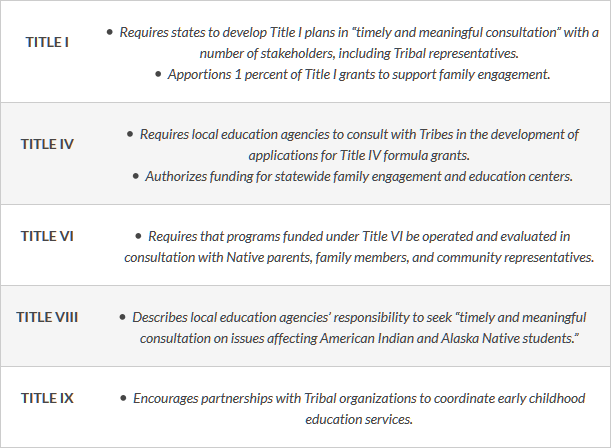ESSA and Native American, Alaska Native, and Native Hawai'ian Students
This is second in a series of posts on ESSA’s implications for student subgroups. Read the first in the series: What Will ESSA Mean for English Learners?
A large body of research supports the idea that Native American, Alaska Native, and Native Hawai'ian students thrive in instructional environments that honor their unique cultural and linguistic heritages.
Federal education policy is catching on.
The Every Student Succeeds Act (ESSA) promises unprecedented opportunities and funding for incorporating our nation’s many indigenous cultures and languages into public schools serving Native students.
History paints a grim picture of the role of the federal government in educating Native youth. Starting in the mid-1800s, U.S. government policy called for eradicating indigenous languages and cultures. Native students were taken from their families and forced to attend boarding schools designed to assimilate them into mainstream American culture. School conditions were often appalling. Students faced brutal punishments for speaking their home languages, and crowded, unsanitary conditions meant that untold numbers of students died from such diseases as cholera and tuberculosis. Not until the 1928 Meriam Report brought national attention to these conditions did public opinion start turning against the forced assimilation of Native children.
Despite efforts to eradicate Native cultures through education, many Native communities and Nations managed to preserve their unique languages and cultures and today are working to revitalize them. Such Native-run schools as the Nkw’usm Salish School in Arlee, Montana; Bug-O-Nay-Ge-Shig School in Bena, Minnesota; and Ayaprun Elitnaurvik Yup'ik Immersion School in Bethel, Alaska, are just a few examples.
At these schools, students achieve academically while growing within their indigenous heritage. One long-standing program in Hawai'i, Ka Papahana Kaiapuni, began with nursery and preschool language immersion in the 1980s and grew steadily to follow students through each school year, all the way to the university level.
Cultural revitalization programs like these found support in the 1990 Native American Languages Act, which protects Native students’ rights to use their languages in public schools. A few federal programs also fund language-revitalization activities, but with 566 federally recognized Native Tribes and Nations, each with its own cultural heritage, more support is needed.
Each Nation’s linguistic and cultural traditions should be incorporated into local school curricula. Three factors are key:
- Community and family engagement. A continuous link between home and school cultures can go a long way toward healing the wounds of the past and may ultimately lead to more academically engaged students. The table below shows how several ESSA provisions require community and family consultation and engagement in education planning.
Provisions for Family and Community Involvement in ESSA

- Culture and Language. The new law further solidifies the status of indigenous language and cultures in public schools through newly appropriated funds that support indigenous language immersion programs. It also allocates additional funds to promote indigenous languages and cultures, culturally responsive education, college and career preparation, dropout prevention, and mental health services.
- Native teachers. Recruitment and retention of Native teachers is critical for maintaining culturally responsive instructional environments. ESSA’s new Title VI explicitly encourages educational activities that incorporate Tribal Elders—in many cases, the only remaining speakers of endangered indigenous languages. Also important, ESSA removes strict definitions of and requirements for “highly qualified” teachers so public schools can better leverage the wisdom and knowledge of Tribal Elders as teachers without requiring them to go through lengthy and often irrelevant certification processes.
The success of these ESSA provisions depends on how well they are implemented. For now, embedding the importance of Native languages and cultures in education policy and providing targeted funding appropriations are important steps.
Erin Haynes is a senior researcher specializing in minority language acquisition.
For more information and to follow federal guidance on ESSA implementation, visit the National Indian Education Association.